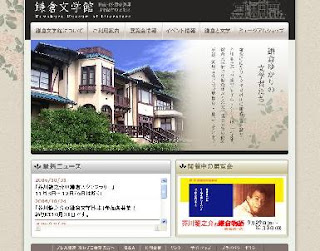Let's start with the museums. I have found the following two:
- There is a small museum in Matsusaka, a historical town in Mie Prefecture, called Ozu Yasujiro Museum "Seishunkan". Ozu was born in downtown Tokyo, but in 1913, at age ten, he was sent to live in his father's hometown Matsusaka. He would stay there until 1924. The museum stands on the spot of the house where Ozu lived, but the house itself has been destroyed by a fire in the 1950s. The museum has been built to resemble on the outside the Kaguraza movie theater (also defunct) that Ozu used to visit in Matsusaka, and inside visitors find a living room, movie room, and commemorative hall. There are videos introducing the director, as well as panels with photos of his work. Note that the small museum is only open on Friday, Saturday, Sunday and Monday.
- Onomichi Motion Picture Museum. Onomichi, a nostalgic port town on the Inland Sea, located in the Eastern part of Hiroshima Prefecture, was and is a favorite shooting location - not only for Ozu who used it in his Tokyo Story. The small Onomichi Picture Museum displays materials and photos connected with film projects that were shot in Onomichi. There is also a tiny theater where visitors can see movies that were filmed in Onomichi. The museum is closed on Tuesdays.
[Onomichi]
When in Kamakura, you may also visit the Kamakura Museum of Literature, which - besides being a beautiful spot, a 1936 Western-style villa with an immense lawn - occasionally may have some materials on view about Ozu.
Another film-related place in Kamakura is the Kawakita Film Museum, which organizes exhibitions and film screenings - Kawakita Nagamasa and his wife Kashiko were founders of the Art Theater Guild (ATG, set up in 1961), which imported foreign art films and also supported independent Japanese directors, as the Nouvelle Vague directors Oshima, Yoshida and Shinoda. The museum stands on the location of their Kamakura residence. This is however not connected to Ozu - the ATG was backed financially by Toho, and not by Shochiku.
The Shochiku studios where Ozu worked (first in Kamata, later in Ofuna) have unfortunately been demolished. It is a pity Shochiku has done nothing for Ozu.
While we are talking about film in general, let me also point to the National Film Center in Tokyo, which organizes screenings and also has a gallery where films stills and posters are shown. See the website for the program. There is also a library.
And then the second point: shooting locations of films by Ozu. There is unfortunately no list of these, and, in fact, most of Ozu's films are made in the studio, on sets recreating the inside of houses and offices. And when we look at the locations Ozu used, we have to conclude that many of these have disappeared or changed beyond recognition. That is for example true for his Tokyo locations - such as the sparsely populated Western suburbs of Tokyo in I was Born, But...
There are two locations that come to mind which are still extant, but then in a generalized way: Onomichi (used in Tokyo Story) and North-Kamakura, used in Late Spring. Onomichi is a beautiful spot, with steep lanes and old temples, looking out over the Inland Sea and an old-fashioned harbor. Just walking around here will allow visitors to imbue the atmosphere of the shots in Tokyo Story. Also see my article Best Traditional Towns in Japan about Onomichi's attractions.
The same is true of Kamakura: away from the main thoroughfares, in the quiet residential areas, there are still long bamboo fences and quiet lanes as shown in Late Spring and other Ozu films.

